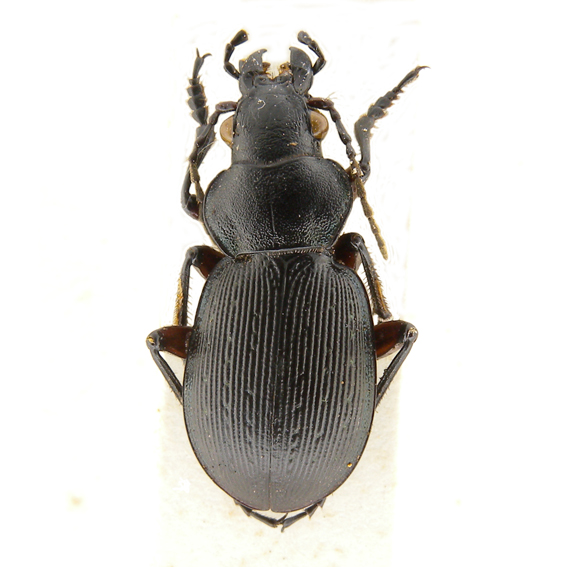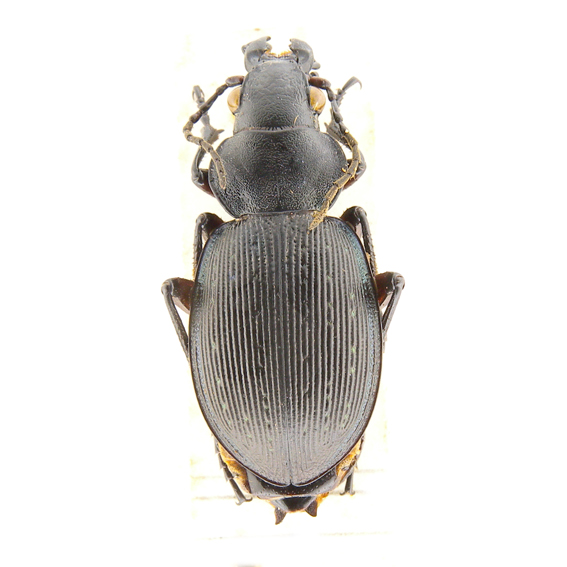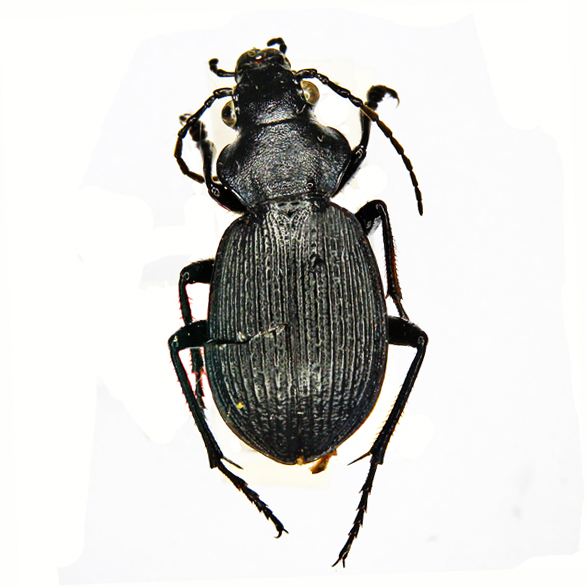Calosoma (Carabops) abyssinicum Gestro, 1880
Calosoma abyssinicum Gestro, 1880: 201 (type locality: Argu Agher); holotype ♂ in Museo civico di Storia naturale di Genova [examined]
Carabops kachovskyi Jakobson, 1900: 263 (described from: Abessinia mer.); type material in Zoological Museum of the Russian Academy of Sciences, Saint Petersburg and in Musée Royal de l'Afrique Central, Tervuren [examined]
Carabops kachovskyi var. femoralis Jakobson, 1900: 264 (type locality: Adis-Abeba) holotype ♂ in Zoological Museum of the Russian Academy of Sciences, Saint Petersburg
Calosoma (Carabomorphus) abyssinicum Breuning, 1928: 130
Carabops abyssinicus Jeannel, 1940: 138
Carabops angustipennis Jeannel 1940: 138 (type locality: Harrar); holotype ♂ in Muséum National d'Histoire Naturelle, Paris [examined]; synonimy established by Rougemont (1976: 268)
Carabops abyssinicus var. hadiacus Rougemont, 1976: 269 (described from: Hosaena); original material: 2♂♂, holotype in Musée Royal de l'Afrique Central, Tervuren [examined]
Length 16-20 mm. C. abyssinicum is characterized by a distinctly transverse pronotum, wider on rear than on the anterior part. The elytra are very short and convex, widened in the posterior third.
Rougemont (1976: 269) described a form (hadiacum) with tertiary intervals reduced, almost obliterated (to which he refers as "hétérodyname"). This form is not worthy of being taken at sub specific level but it is a good example of the great variability of the sculpture of the elytra, in this species as well as in the related one C. aetiopicum.
Jeannel (1940: 138) had previously described a new species C. angustipenne, based on single male, that was characterized, in comparison with C. abyssinicum by its elongated shape, but Rougemont (1976: 268) has considered C. angustipenne synonymous of C. abyssinicum, denying the constancy of the characteristics. As matter of fact, the only known individual of C. angustipenne, is characterized by a slender body shape but the shape of the pronotum and the sculpture of the elytra are very similar to the ones that characterize C. abyssinicum. C. abyssinicum would therefore also be present in Hararge where C. aethiopicum and C. harrarense are also living, but, the scarcity of recent findings and the lack of exact indications of locality, do not allow to form a definite opinion on the actual distribution of the three species.
The only reliable data we have, however, allow us to state that C. abyssinicum is present on the Shewa plateau (at an altitude around 3000m - 3100m), and in mountain chains on the south-eastern side of the Rift Valley (from 3200m. down to 2100m), occupying the ancient provinces of Shewa, Hararghe, Arsi, Bale, Gamo Gofa, Sidamo.
Examined specimens and literature’s data
Ethiopia. Arsi: Mendebo Mts. ( = Monte Encuolò, = tra Bucoggi e Sella di Carrà) (AVT); between Shashamane and Dodola (SB), between Sasheme and Dodola, Mt. Mascall 3100-3300 (http://www.carabidae.ru); Bale: 38km W Dinshu (Rougemont, 1976: 267); Gamo Gofa: Hosaena (type hadiacus, RMCA), Chencha (Rougemont, 1976: 267); Hararghe: env. of Harrar (type of angustipennis, MNHN); Shewa: Argu Agher (type, MGe), Schonkora (between Addis Abeba and Debre Markos), Sekuala (= Zuqualla) (Jakobson, 1900: 264), Let Marefià (AC, MGe), Entotto (GP, SB), env. of Addis Ababa (SB), Mt. Mugo (SB), Mt. Ouaciacia (SB), Mt. Zuquala (Basilewsky, 53: 276), Mt Salale, 40km N Addis Abeba, 90km SW Addis Abeba, Cacha valley, 25km NE Wolisso, Termaber Pass (Rougemont, 1976: 267), Addis Alem (TL); Sidamo: 15 km NW Kebre Mengist (SB), Agere Selam (Rougemont, 1976: 267) .
Notes: Brachypterous. Adults are primarily nocturnal. It adapts to different environments such as margins of cultivated fields and pastures, but it is especially common in wooded areas, including small size ones, between 2200 and 3200m. In the Shewa plateau the adults were found in activity during the entire rainy period and in the immediately following months. It is more frequent in the initial period of rainy between May and June, which is also the period of mating and laying. Then reappears in number in the end of rainy period, from September to October, and remains active until November. In other areas of its distribution area the phenology remains conditioned to the rainfall regime but limited temporal shifts are possible due to local values of humidity and temperature.
The description of the first and second larval instar is found in Vigna Taglianti & Bruschi (1986: 9).
 Gestro, 1880 Ethiopia: Shewa, Entoto (Goggiam road, 10 km N Addis Ababa), 2.V1.1985, Bruschi leg. |
 Gestro, 1880 Ethiopia: Shewa, Entoto (Goggiam road, 10 km N Addis Ababa), 2.V1.1985, Bruschi leg. |
 Gestro, 1880 Ethiopia: Shewa, Mt. Ouaciacia (Menaghesha Nat. For.). m.3000, 20 km SW Addis Abeba, 9,VI.1985, Bruschi leg. |
 Gestro, 1880 Ethiopia: Shewa, Mt. Ouaciacia (Menaghesha Nat. For.). m.3000, 20 km SW Addis Abeba, 9,VI.1985, Bruschi leg. |
 Gestro, 1880 Ethiopia: Hosaena, Kambata, alt. 2300m, 27.V.1974 de Rougemont (type of Carabops abyssinicus hadiacus) Musée Royal de l'Afrique Central, Tervuren |
 Gestro, 1880 Adis-Abeba, Abessin merid., Kakowsky 29.V.98, Mus. Acad. Sc. Petersb. (type of Carabops abyssinicus kachovskyi) Musée Royal de l'Afrique Central, Tervuren |
 Gestro, 1880 Ethiopia: environs de Harrar, Kachovsky, ex coll. Maindron (Typus of Carabops angustipennis Jeannel, 1940) (coll. Muséum National d'Histoire Naturelle, Paris) |